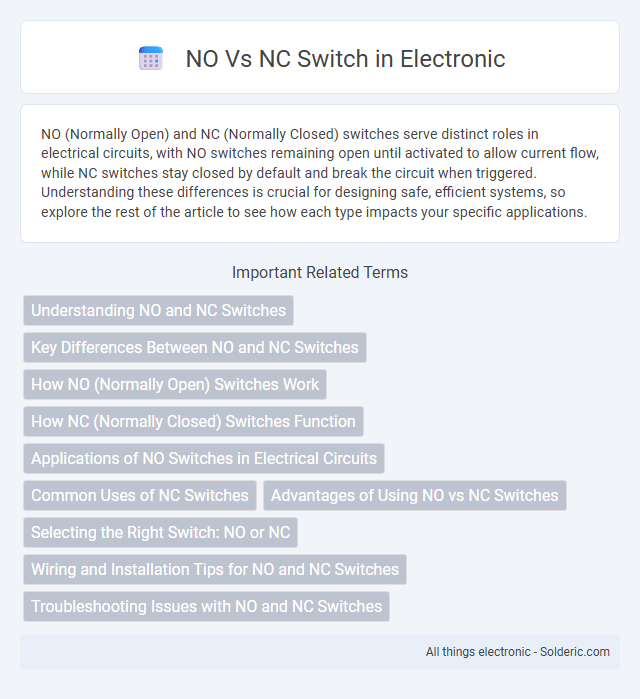NO (Normally Open) and NC (Normally Closed) switches serve distinct roles in electrical circuits, with NO switches remaining open until activated to allow current flow, while NC switches stay closed by default and break the circuit when triggered. Understanding these differences is crucial for designing safe, efficient systems, so explore the rest of the article to see how each type impacts your specific applications.
Comparison Table
| Feature | NO (Normally Open) Switch | NC (Normally Closed) Switch |
|---|---|---|
| Default State | Open circuit (off) | Closed circuit (on) |
| Operation | Closes circuit when activated | Opens circuit when activated |
| Common Applications | Push buttons, alarms, sensors | Safety switches, emergency stops |
| Signal Behavior | Signal present only on activation | Signal lost on activation |
| Reliability | Less fail-safe in power loss | More fail-safe in power loss |
Understanding NO and NC Switches
NO (Normally Open) and NC (Normally Closed) switches are fundamental components in electrical circuits, controlling the flow of current based on their default states. NO switches remain open when inactive, allowing current to pass only when engaged, commonly used in applications requiring activation signals. NC switches stay closed by default, maintaining current flow until triggered to open, often employed for safety mechanisms and fail-safe operations.
Key Differences Between NO and NC Switches
NO (Normally Open) switches remain open when inactive, breaking the circuit until activated to close and complete it, commonly used in applications like push-button starters. NC (Normally Closed) switches stay closed when inactive, maintaining the circuit connection until triggered to open and break the circuit, frequently employed in safety interlocks and emergency stop devices. The key difference lies in their default state and how they control current flow, affecting their suitability for specific control and safety functions.
How NO (Normally Open) Switches Work
NO (Normally Open) switches remain open in their default state, preventing electrical current from flowing through the circuit until the switch is activated. When You press or toggle the switch, the contacts close, allowing current to pass and completing the circuit. These switches are commonly used in applications where the circuit should be off until intentionally turned on, such as push-button controls and safety interlocks.
How NC (Normally Closed) Switches Function
NC (Normally Closed) switches maintain a closed electrical circuit by default, allowing current to flow until the switch is activated. When triggered, the NC switch opens the circuit, interrupting the current and stopping the flow. This design ensures continuous operation and automatic disconnection in safety or control applications when an event occurs.
Applications of NO Switches in Electrical Circuits
NO (Normally Open) switches are widely used in electrical circuits for applications requiring controlled activation, such as push-button starters, alarm systems, and lighting controls. These switches remain open until physically pressed or actuated, allowing current to flow only when the circuit needs to be completed. Your devices benefit from reliable NO switch deployment to ensure safe and precise operation in momentary or trigger-based control systems.
Common Uses of NC Switches
NC (Normally Closed) switches are commonly used in safety and security systems where default circuit continuity is essential, such as emergency stop buttons and alarm circuits to ensure immediate disconnection when activated. They serve in applications requiring fail-safe operation, including machinery controls and door interlocks, ensuring the device stops running if the switch circuit is broken. Your equipment's reliability improves by integrating NC switches to maintain continuous power or signal flow until a specific action interrupts the circuit.
Advantages of Using NO vs NC Switches
NO (Normally Open) switches provide advantages such as safety and energy efficiency by only completing the circuit when activated, reducing the risk of unintended operation and power consumption. They are ideal for applications where the default state requires no current flow, enhancing system longevity and minimizing wear on components. Your designs benefit from simpler troubleshooting and maintenance due to the clear distinction between off (open) and on (closed) states inherent in NO switches.
Selecting the Right Switch: NO or NC
Selecting the right switch between Normally Open (NO) and Normally Closed (NC) depends on your application's default state requirements and safety considerations. NO switches are ideal when you want the circuit to remain off until activated, while NC switches maintain a closed circuit and break only when triggered, offering fail-safe operation. Understanding whether your system needs to default to an active or inactive state helps ensure reliable performance and prevents unintended failures.
Wiring and Installation Tips for NO and NC Switches
When wiring NO (Normally Open) switches, connect the load to the switch terminals so the circuit closes only when the switch is activated, ensuring no current flows when inactive. For NC (Normally Closed) switches, wiring involves connecting the load such that the circuit remains closed until the switch is triggered to open, providing fail-safe operation. Proper installation requires verifying terminal labels and using appropriate insulation to prevent shorts, while testing the switch function with a multimeter before finalizing connections guarantees reliable performance.
Troubleshooting Issues with NO and NC Switches
Troubleshooting issues with NO (Normally Open) and NC (Normally Closed) switches often involves verifying the switch's baseline state using a multimeter to check for continuity or resistance changes when actuated. Faults can arise from mechanical wear, dirt accumulation, or wiring errors that cause switches to fail in detecting correct open or closed states. Ensuring proper wiring diagrams align with the specific NO or NC configuration and testing under load conditions helps isolate and resolve switch malfunctions effectively.
NO vs NC switch Infographic

 solderic.com
solderic.com